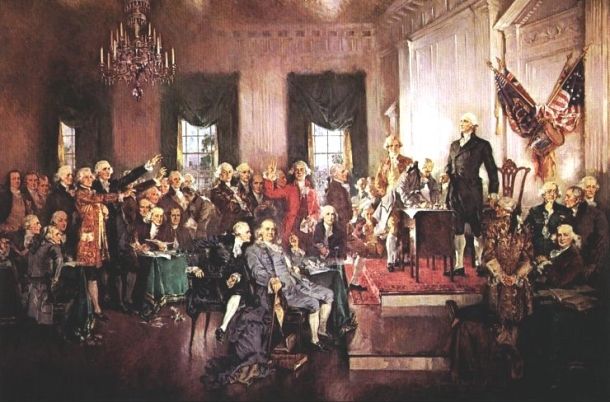 username@email.com
username@email.com
This lesson will review the creation of the Constitution in addition to reviewing its basic components.
Previously the causes and conditions that led to war between the colonists and Britain were reviewed. Also covered were some of the key events of the war as well as a brief summary of the components of the Declaration of Independence.
After the Revolutionary War, the newly formed United States of America needed to decide what would be its ultimate form of government. In the midst of fighting a long and hard struggle to free themselves from the control of the British crown, the colonists also struggled with the idea of a strong central government. The Second Continental Congress deliberated for one year before producing the Articles of Confederation and Perpetual Union, which gathered the former colonies into a loose confederation with a weak central government and most of the power remaining in the hands of the states. Commonly referred to as the Articles of Confederation, this document seemed to the delegates to be the best idea at the time, but it would prove to be deeply flawed and would remain in force for only seven years before being replaced by the Constitution.
After the war with Britain, the newly minted country needed to centralize its government. The Continental Congress had difficulty getting representation from each colony, which made for a painfully slow decision-making process. With such a loose form of centralized government, imposing taxes to pay war debts was also a difficult task.
In 1786 and 1787, delegates from around the country met in Philadelphia, ostensibly to revise the existing Articles of Confederation. However, the Congress agreed to create a constitution that would set the course for a new nation.
Below is a review of the basic components of the Constitution. More detailed reviews of this document will appear in other lessons.
The preamble functions as an overview and mission statement for the entire document. Hover here to see the text of the preamble.
The articles define the sections of the federal government and their attendant powers. This section establishes the legislative, judicial, and executive branches of the government. Article Five explains the process to amend the document.
There are twenty-seven amendments to the Constitution; the first ten are known as the Bill of Rights.

Scene at the signing of the Constitution of the United States by American Artist Howard Chandler Christy
The signatories of the U.S. Constitution are some of the nation’s iconic figures. Here are some of the important figures who affixed their signatures to the Constitution.
The first president, Washington was so revered that some Americans called for him to retain power for life. However, he stepped down after serving two terms as president, which set the tone for all subsequent presidents until FDR, who served four terms.
A protégé of Thomas Jefferson, Madison led the charge to replace the outdated Articles of Confederation. He was elected president in 1808.
An American renaissance man, Franklin was a member of the Continental Congress and a major contributor to the Declaration of Independence.